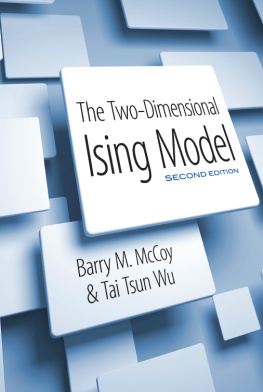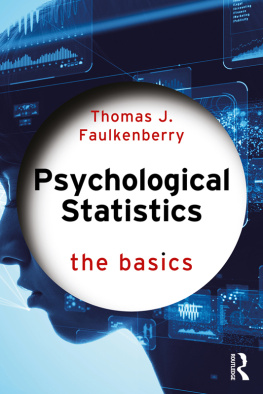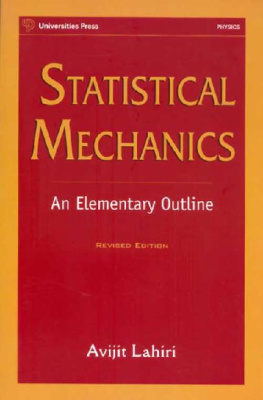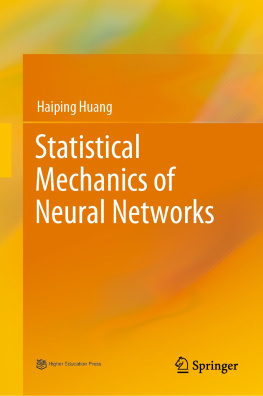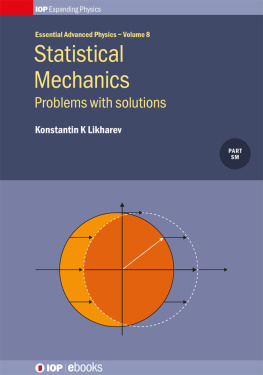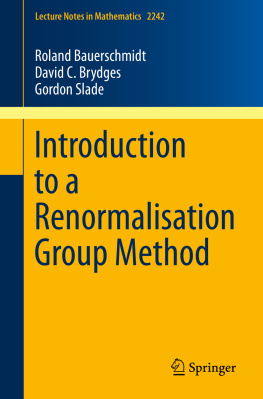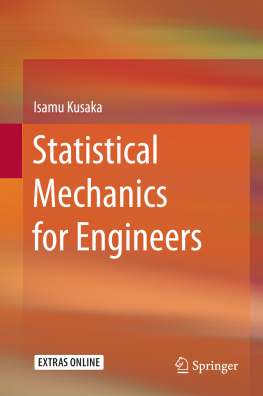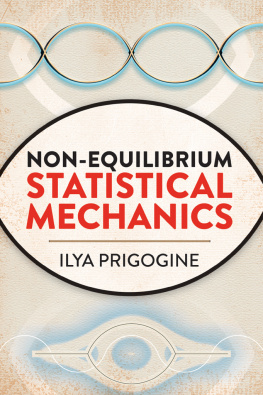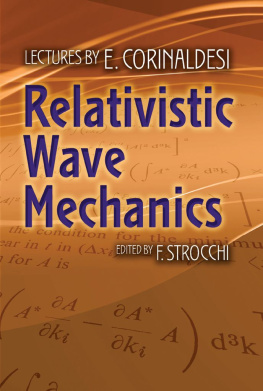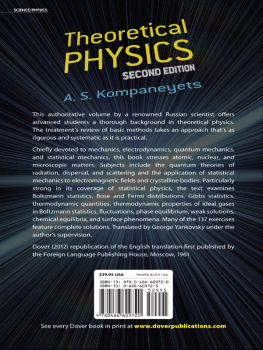The Two-Dimensional Ising Model The Two-Dimensional Ising Model The Two-Dimensional Ising Model Barry M. McCoy Stony Brook University Tai Tsun Wu Harvard University Dover Publications, Inc.
Mineola, New York Copyright Copyright 1973 by Harvard University Press Copyright 2001, 2014 by Barry M. McCoy and Tai Tsun Wu All rights reserved. Bibliographical Note This Dover edition, first published in 2014, is an unabridged and slightly corrected republication of the work originally published by Harvard University Press, Cambridge, Massachusetts, in 1973. The authors have added a new Preface to the Dover Edition as well as a new chapter at the end of the book (). International Standard Book NumbereISBN-13: 978-0-486-78312-3
ISBN-10: 0-486-49335-0 Manufactured in the United States by Courier Corporation
49335001 2014
www.doverpublications.com TO CHEN NING YANG AND SAU-LAN YU without whom it would have been impossible Preface to the Dover edition When the first edition of this book was published 40 years ago in 1973 the results presented were up-to-date and complete.
However, very shortly after the book was published major new results were obtained which demonstrated that in the scaling limit near the critical temperature the two point function for a suitably large separation between the spins satisfied a Painlev equation of the third kind. Since that time there have been many further major advances in our understanding of the Ising model and the book has become seriously out of date. Over the years we have been asked by many people to rectify this problem by writing a new book which would derive the many significant results which have been obtained since 1973. This is a monumental task which we have been quite reluctant to undertake. However, it is, in our opinion, important to make these results available to the community of mathematical physicists and to mathematicians who work on solvable models in statistical mechanics. When Dover proposed to issue a reprint of the first edition it seemed to be a unique opportunity to present the results of the last 40 years by adding a new final chapter to the original text of 1973.
This was the inspiration for what is now . In the space of one chapter it is quite impractical to present the derivations of these results and instead we give references to the original papers where the results are first derived. However different authors use different notations, conventions, and normalizations, and, consequently, the process of presenting these results in one common notation results at times in the results quoted not being literally the same as what is in the original papers. We have no illusions, however, that this final chapter will be the last word in the development of the Ising model because there are many open questions presented there for which, as was similarly said in the epilogue of the 1973 edition, progress can certainly be made. It is our hope that this book will stimulate that progress. Barry M McCoy Stony Brook University Tai Tsun Wu Harvard University 2013 PREFACE Of all the systems in statistical mechanics on which exact calculations have been performed, the two-dimensional Ising model is not only the most thoroughly investigated; it is also the richest and most profound.
In 1925, Ising introduced the statistical system which now bears his name and studied some of its properties in one dimension. Although the generalization of Isings system to higher dimensions was immediately obvious, it was not until 1941 that a quantitative statement about the phase transition in the two-dimensional case was made when Kramers and Wannier and also Montroll computed the Curie (or critical) temperature. However, the most remarkable development was made in 1944 when Onsager was able to compute the thermodynamic properties of the two-dimensional lattice in the absence of a magnetic field. Onsagers approach was greatly simplified by Kaufman in 1949, and in a companion paper Kaufman and Onsager studied spin correlation functions. The spontaneous magnetization was first published, without derivation, by Onsager in 1949, and the first derivation was given by Yang in 1952. For the next decade no new result of fundamental significance was derived, but a great deal was accomplished in simplifying the mathematics of these pioneering papers.
The work of Kac, Kasteleyn, Montroll, Potts, Szeg, and Ward, among others, has been especially significant. The methods of Onsager, Kaufman, and Yang, although very beautiful and powerful, are also extremely complicated. Thus, the two-dimensional Ising model has acquired a notorious reputation for difficulty whereas, in fact, the simplified methods developed by 1963 have reduced the analysis to the point where it may be readily understood. Since then we have actively used these methods as the basis for computing many more quantities of physical interest. Our original concern was with the spin correlation functions of the two-dimensional Ising model. However, it soon became apparent that much more could be studied.
In particular, we found that the Ising model has properties which exhibit a hysteresis behavior. Moreover, we discovered that exact results can be obtained even in a much more complicated situation where the interaction between the spins is allowed to be a random variable. On the basis of these results, a quantitative study of the influence of impurities on phase transitions has been carried out. This influence is large and has experimental consequences that have yet to be fully explored. Since the two-dimensional Ising model forms the basis of much of our theoretical understanding of phase transitions, it is unfortunate that these recent developments have not been easily accessible to the general community of physicists. Perhaps as a result of its notoriety, most physicists tend to think of the two-dimensional Ising model as a closed problem that was completely solved by Onsager, Kaufman, and Yang.
Moreover, once a physicist does become aware of the wide variety of open questions there is no convenient place where he can find the known facts collected together and explained in an organized fashion. Furthermore, even if one has the patience to trace the references back to Kasteleyns paper of 1961, the usual result is a feeling of confusion. This confusion arises not out of any errors in the published work, but out of the fact that in journal articles many things must be omitted owing to lack of space. Therefore, points that can be straightened out and rigorously shown to cause no problems are often treated very briefly. The careful reader therefore has questions that he must resolve for himself and the resolutions are frequently quite time consuming. The study of the two-dimensional Ising model requires the use of mathematics from such apparently widely separated areas as the theory of determinants and integral equations.
Few physicists are knowledgeable in all these branches of mathematics. Therefore, a formula that may have been well known to a mathematician of 100 years ago may be totally unknown to a physicist of today. It is quite impossible to discuss such a formula in a journal article. One must call it well known, give a reference, and go on. But the reference is often useless because, while correct, it usually is so arranged that the reader must spend an inordinate amount of time in mastering a lot of notation which is mostly superfluous if he wants to derive only one particular formula. For example, in our study of Ising-model spin correlation functions we make extensive use of the theory of Wiener-Hopf sum equations.
Except as an afterthought to the theory of Wiener-Hopf integral equations, these sum equations are rarely discussed in the literature. This circumstance often leads one to believe that the sum equations are harder than the integral equations. In fact they are simpler. For these reasons we feel that it is at this time most desirable to write a book on the two-dimensional Ising model that has the following three goals: (1)It should be completely up to date and be crystal clear in its statement of what is known and, more important, what is as yet unknown. (2)It should discuss all topics in complete detail. (3)It should strive to be self-contained. (3)It should strive to be self-contained.
Next page
